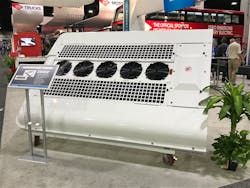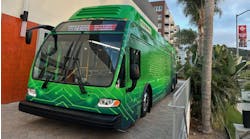All About Batteries: Optimizing Efficiencies for Heating and Cooling Buses
While it can increase the capacity needs for an electric vehicle, affecting the maximum range of an hybrid electric or electric vehicle, passenger comfort cannot be compromised.
“HVAC is the largest single load on the battery, so we have to do what we can to make our units as efficient as possible,” said Steve Johnson, product marketing manager, Bus HVAC, Thermo King. “The range [of an electric vehicle] can be compromised using an HVAC unit, so it’s imperative to have an efficient heating and cooling unit on a bus.”
Thermo King, a leading HVAC supplier to the North American transit market has been providing heating, cooling and ventilation solutions for buses since 1956.
To address the demand for efficient heating and cooling solutions, Thermo King has two new all-electric, hermetically sealed rooftop HVAC units on display at APTA Expo: The Athenia AMII E-800 and the RLF-E.
Both units are designed for battery bus, hybrid bus, trolley bus and engine-driven alternator-powered applications.
The units feature a rugged, one-piece design which provides durability and ease of installation. The systems come from the factory pre-charged with R-407C refrigerant and all pipes and fittings are enclosed within the system. The absence of hoses and fittings external to the unit drastically improves reliability, lowers maintenance costs and overall life-cycle costs.
The Athenia AMII E-800 and the RLF-E can both deliver the same capacity at all vehicle speeds and optimizes energy efficiency through the intelligent control system.
Johnson highlighted the all-metal blower housing as an added safety feature of the Athenia AMII E-800 HVAC system.
“Heaters get very hot, even when you shut them off it takes a lot of time for the heat to dissipate. Metal is a lot safer package than plastic and significantly reduces the incident of something happening.”
The RLF-E unit features high-voltage AC electric compressors, and low-voltage DC blowers, allowing for optimized operation by varying speeds as needed.
“Typically you start out with a hot bus and cool it down, and everything is running at high speed,” said Johnson. “Once the bus gets cooled, one of those compressors shuts off, and we can vary the air movement so they’re not taking as much power.”




